Analysis of Organizational Behavior: CAPCO and ASDA Comparison Report
VerifiedAdded on 2020/01/15
|21
|6686
|154
Report
AI Summary
This report provides a detailed analysis of organizational behavior, focusing on the comparison between CAPCO and ASDA. It explores the relationship between organizational structure and culture, examining their impact on business performance. The report delves into the factors influencing individual behavior within organizations, including personal, environmental, and organizational aspects. It further evaluates the effectiveness of different leadership styles, comparing democratic and autocratic approaches in CAPCO and ASDA, respectively, and discusses the influence of organizational theories on management practices. The impact of leadership styles on motivation is analyzed, along with a comparison of motivational theories within CAPCO. The report also assesses the nature of groups and group behavior in CAPCO, exploring factors affecting teamwork and the impact of technology on team functioning, culminating in a comprehensive understanding of organizational dynamics.
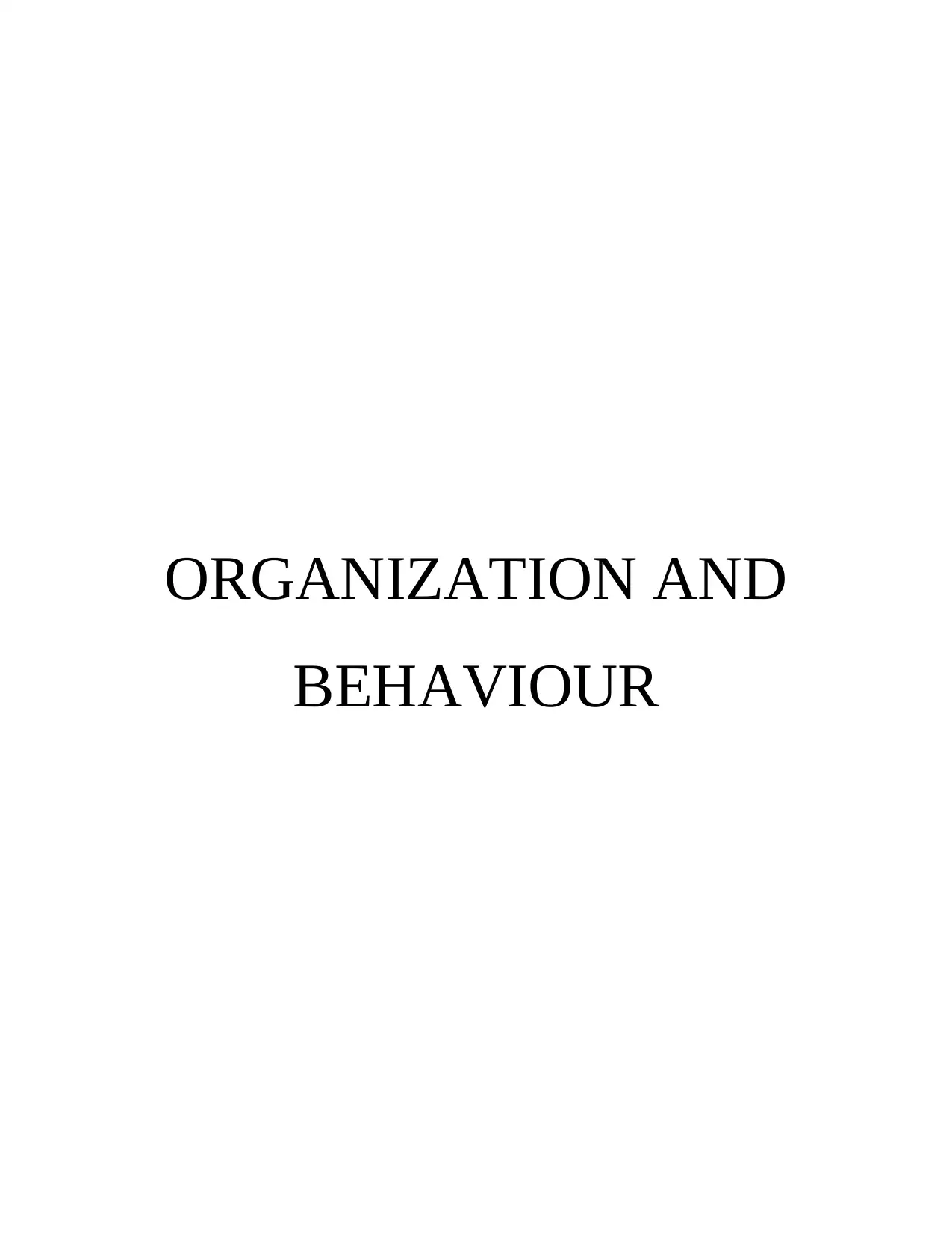
ORGANIZATION AND
BEHAVIOUR
BEHAVIOUR
Paraphrase This Document
Need a fresh take? Get an instant paraphrase of this document with our AI Paraphraser
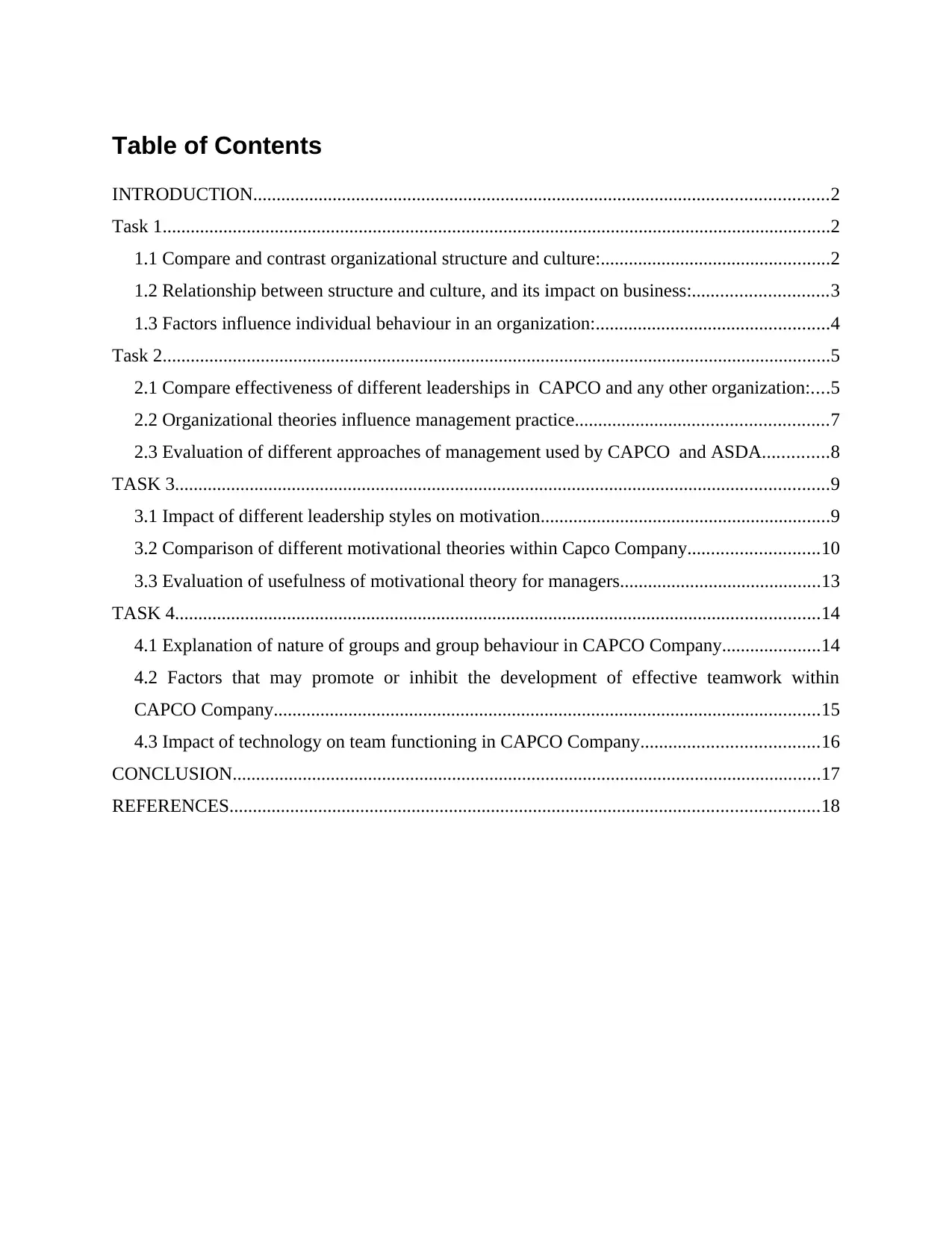
Table of Contents
INTRODUCTION...........................................................................................................................2
Task 1...............................................................................................................................................2
1.1 Compare and contrast organizational structure and culture:.................................................2
1.2 Relationship between structure and culture, and its impact on business:.............................3
1.3 Factors influence individual behaviour in an organization:..................................................4
Task 2...............................................................................................................................................5
2.1 Compare effectiveness of different leaderships in CAPCO and any other organization:....5
2.2 Organizational theories influence management practice......................................................7
2.3 Evaluation of different approaches of management used by CAPCO and ASDA..............8
TASK 3............................................................................................................................................9
3.1 Impact of different leadership styles on motivation..............................................................9
3.2 Comparison of different motivational theories within Capco Company............................10
3.3 Evaluation of usefulness of motivational theory for managers...........................................13
TASK 4..........................................................................................................................................14
4.1 Explanation of nature of groups and group behaviour in CAPCO Company.....................14
4.2 Factors that may promote or inhibit the development of effective teamwork within
CAPCO Company.....................................................................................................................15
4.3 Impact of technology on team functioning in CAPCO Company......................................16
CONCLUSION..............................................................................................................................17
REFERENCES..............................................................................................................................18
INTRODUCTION...........................................................................................................................2
Task 1...............................................................................................................................................2
1.1 Compare and contrast organizational structure and culture:.................................................2
1.2 Relationship between structure and culture, and its impact on business:.............................3
1.3 Factors influence individual behaviour in an organization:..................................................4
Task 2...............................................................................................................................................5
2.1 Compare effectiveness of different leaderships in CAPCO and any other organization:....5
2.2 Organizational theories influence management practice......................................................7
2.3 Evaluation of different approaches of management used by CAPCO and ASDA..............8
TASK 3............................................................................................................................................9
3.1 Impact of different leadership styles on motivation..............................................................9
3.2 Comparison of different motivational theories within Capco Company............................10
3.3 Evaluation of usefulness of motivational theory for managers...........................................13
TASK 4..........................................................................................................................................14
4.1 Explanation of nature of groups and group behaviour in CAPCO Company.....................14
4.2 Factors that may promote or inhibit the development of effective teamwork within
CAPCO Company.....................................................................................................................15
4.3 Impact of technology on team functioning in CAPCO Company......................................16
CONCLUSION..............................................................................................................................17
REFERENCES..............................................................................................................................18
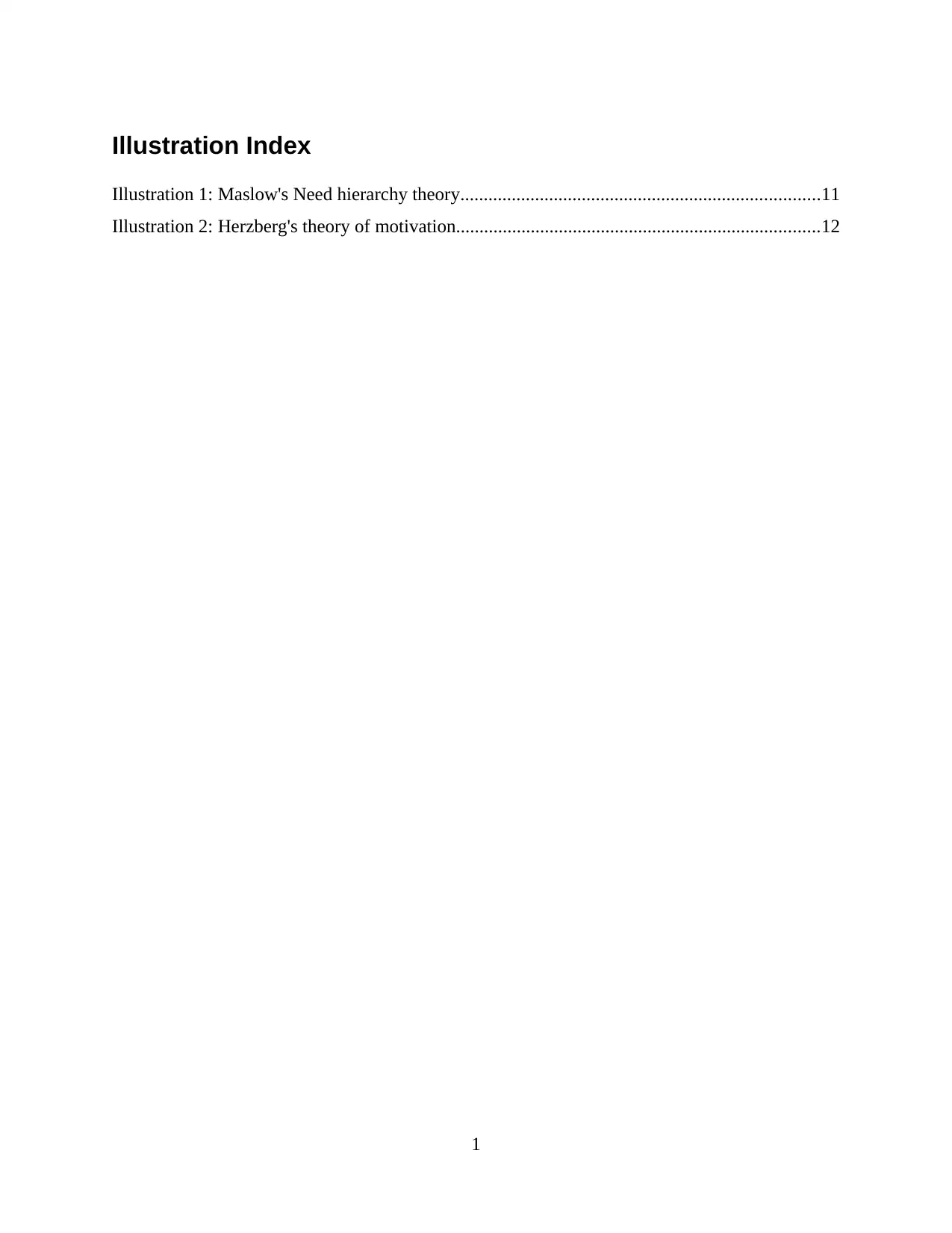
Illustration Index
Illustration 1: Maslow's Need hierarchy theory.............................................................................11
Illustration 2: Herzberg's theory of motivation..............................................................................12
1
Illustration 1: Maslow's Need hierarchy theory.............................................................................11
Illustration 2: Herzberg's theory of motivation..............................................................................12
1
⊘ This is a preview!⊘
Do you want full access?
Subscribe today to unlock all pages.

Trusted by 1+ million students worldwide
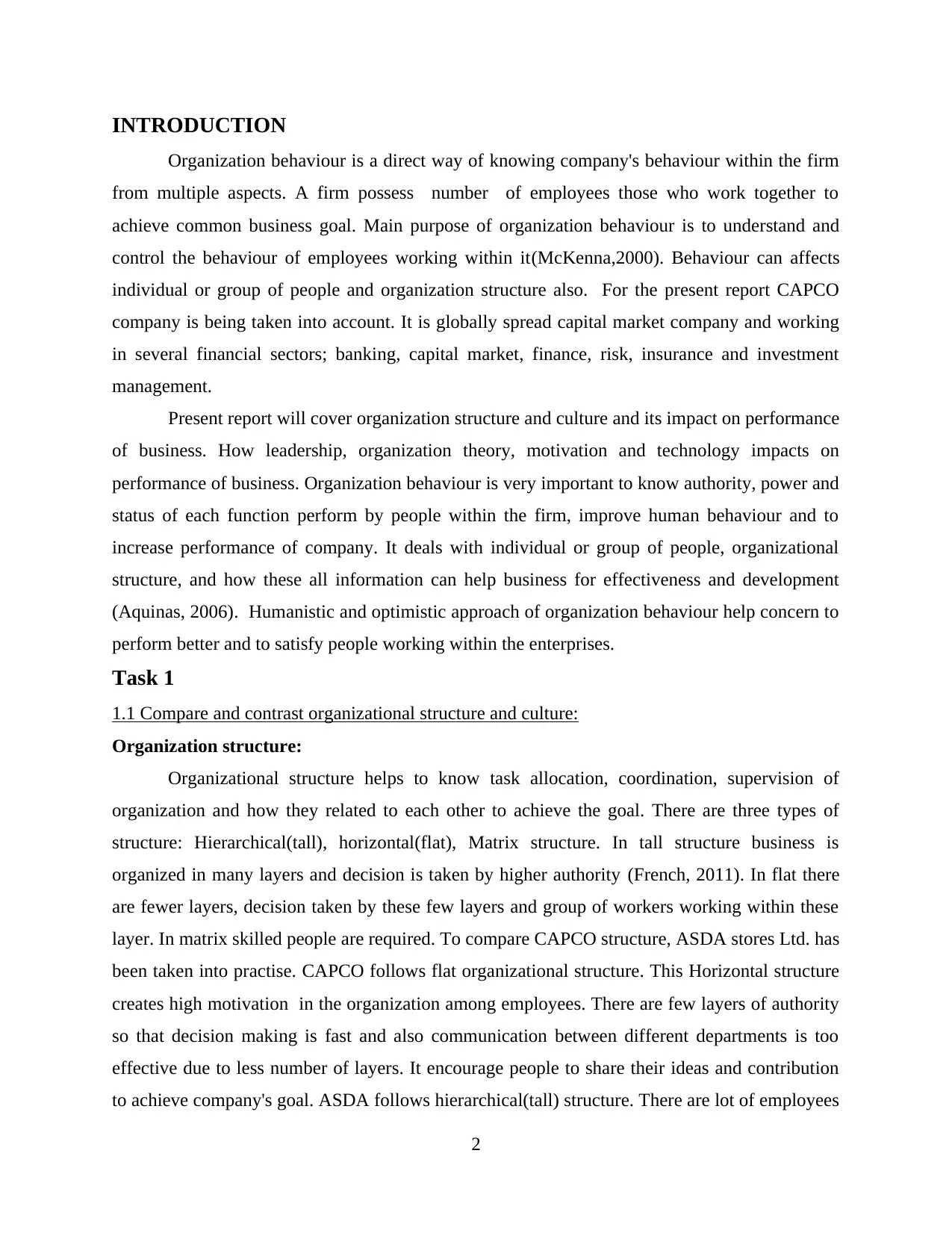
INTRODUCTION
Organization behaviour is a direct way of knowing company's behaviour within the firm
from multiple aspects. A firm possess number of employees those who work together to
achieve common business goal. Main purpose of organization behaviour is to understand and
control the behaviour of employees working within it(McKenna,2000). Behaviour can affects
individual or group of people and organization structure also. For the present report CAPCO
company is being taken into account. It is globally spread capital market company and working
in several financial sectors; banking, capital market, finance, risk, insurance and investment
management.
Present report will cover organization structure and culture and its impact on performance
of business. How leadership, organization theory, motivation and technology impacts on
performance of business. Organization behaviour is very important to know authority, power and
status of each function perform by people within the firm, improve human behaviour and to
increase performance of company. It deals with individual or group of people, organizational
structure, and how these all information can help business for effectiveness and development
(Aquinas, 2006). Humanistic and optimistic approach of organization behaviour help concern to
perform better and to satisfy people working within the enterprises.
Task 1
1.1 Compare and contrast organizational structure and culture:
Organization structure:
Organizational structure helps to know task allocation, coordination, supervision of
organization and how they related to each other to achieve the goal. There are three types of
structure: Hierarchical(tall), horizontal(flat), Matrix structure. In tall structure business is
organized in many layers and decision is taken by higher authority (French, 2011). In flat there
are fewer layers, decision taken by these few layers and group of workers working within these
layer. In matrix skilled people are required. To compare CAPCO structure, ASDA stores Ltd. has
been taken into practise. CAPCO follows flat organizational structure. This Horizontal structure
creates high motivation in the organization among employees. There are few layers of authority
so that decision making is fast and also communication between different departments is too
effective due to less number of layers. It encourage people to share their ideas and contribution
to achieve company's goal. ASDA follows hierarchical(tall) structure. There are lot of employees
2
Organization behaviour is a direct way of knowing company's behaviour within the firm
from multiple aspects. A firm possess number of employees those who work together to
achieve common business goal. Main purpose of organization behaviour is to understand and
control the behaviour of employees working within it(McKenna,2000). Behaviour can affects
individual or group of people and organization structure also. For the present report CAPCO
company is being taken into account. It is globally spread capital market company and working
in several financial sectors; banking, capital market, finance, risk, insurance and investment
management.
Present report will cover organization structure and culture and its impact on performance
of business. How leadership, organization theory, motivation and technology impacts on
performance of business. Organization behaviour is very important to know authority, power and
status of each function perform by people within the firm, improve human behaviour and to
increase performance of company. It deals with individual or group of people, organizational
structure, and how these all information can help business for effectiveness and development
(Aquinas, 2006). Humanistic and optimistic approach of organization behaviour help concern to
perform better and to satisfy people working within the enterprises.
Task 1
1.1 Compare and contrast organizational structure and culture:
Organization structure:
Organizational structure helps to know task allocation, coordination, supervision of
organization and how they related to each other to achieve the goal. There are three types of
structure: Hierarchical(tall), horizontal(flat), Matrix structure. In tall structure business is
organized in many layers and decision is taken by higher authority (French, 2011). In flat there
are fewer layers, decision taken by these few layers and group of workers working within these
layer. In matrix skilled people are required. To compare CAPCO structure, ASDA stores Ltd. has
been taken into practise. CAPCO follows flat organizational structure. This Horizontal structure
creates high motivation in the organization among employees. There are few layers of authority
so that decision making is fast and also communication between different departments is too
effective due to less number of layers. It encourage people to share their ideas and contribution
to achieve company's goal. ASDA follows hierarchical(tall) structure. There are lot of employees
2
Paraphrase This Document
Need a fresh take? Get an instant paraphrase of this document with our AI Paraphraser
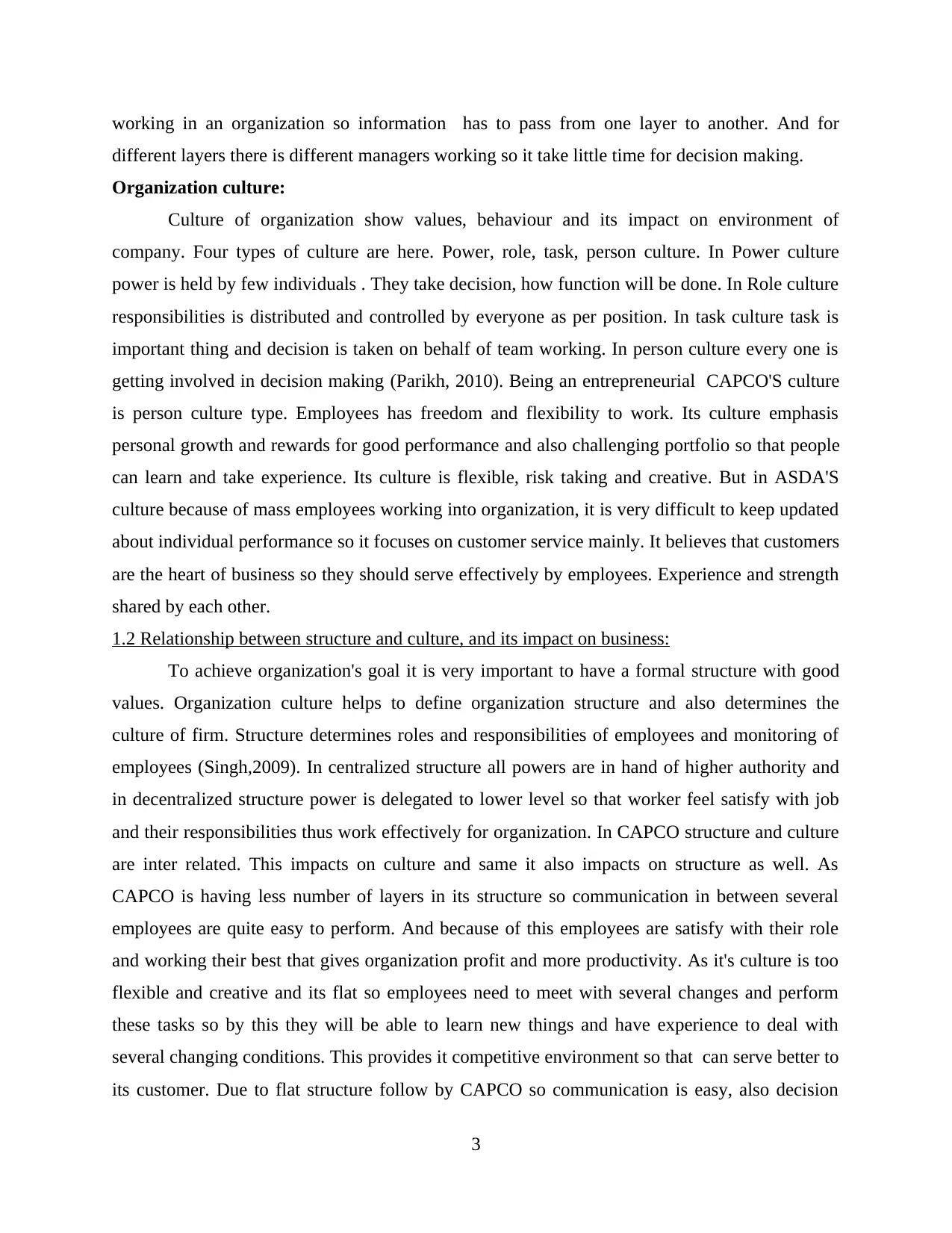
working in an organization so information has to pass from one layer to another. And for
different layers there is different managers working so it take little time for decision making.
Organization culture:
Culture of organization show values, behaviour and its impact on environment of
company. Four types of culture are here. Power, role, task, person culture. In Power culture
power is held by few individuals . They take decision, how function will be done. In Role culture
responsibilities is distributed and controlled by everyone as per position. In task culture task is
important thing and decision is taken on behalf of team working. In person culture every one is
getting involved in decision making (Parikh, 2010). Being an entrepreneurial CAPCO'S culture
is person culture type. Employees has freedom and flexibility to work. Its culture emphasis
personal growth and rewards for good performance and also challenging portfolio so that people
can learn and take experience. Its culture is flexible, risk taking and creative. But in ASDA'S
culture because of mass employees working into organization, it is very difficult to keep updated
about individual performance so it focuses on customer service mainly. It believes that customers
are the heart of business so they should serve effectively by employees. Experience and strength
shared by each other.
1.2 Relationship between structure and culture, and its impact on business:
To achieve organization's goal it is very important to have a formal structure with good
values. Organization culture helps to define organization structure and also determines the
culture of firm. Structure determines roles and responsibilities of employees and monitoring of
employees (Singh,2009). In centralized structure all powers are in hand of higher authority and
in decentralized structure power is delegated to lower level so that worker feel satisfy with job
and their responsibilities thus work effectively for organization. In CAPCO structure and culture
are inter related. This impacts on culture and same it also impacts on structure as well. As
CAPCO is having less number of layers in its structure so communication in between several
employees are quite easy to perform. And because of this employees are satisfy with their role
and working their best that gives organization profit and more productivity. As it's culture is too
flexible and creative and its flat so employees need to meet with several changes and perform
these tasks so by this they will be able to learn new things and have experience to deal with
several changing conditions. This provides it competitive environment so that can serve better to
its customer. Due to flat structure follow by CAPCO so communication is easy, also decision
3
different layers there is different managers working so it take little time for decision making.
Organization culture:
Culture of organization show values, behaviour and its impact on environment of
company. Four types of culture are here. Power, role, task, person culture. In Power culture
power is held by few individuals . They take decision, how function will be done. In Role culture
responsibilities is distributed and controlled by everyone as per position. In task culture task is
important thing and decision is taken on behalf of team working. In person culture every one is
getting involved in decision making (Parikh, 2010). Being an entrepreneurial CAPCO'S culture
is person culture type. Employees has freedom and flexibility to work. Its culture emphasis
personal growth and rewards for good performance and also challenging portfolio so that people
can learn and take experience. Its culture is flexible, risk taking and creative. But in ASDA'S
culture because of mass employees working into organization, it is very difficult to keep updated
about individual performance so it focuses on customer service mainly. It believes that customers
are the heart of business so they should serve effectively by employees. Experience and strength
shared by each other.
1.2 Relationship between structure and culture, and its impact on business:
To achieve organization's goal it is very important to have a formal structure with good
values. Organization culture helps to define organization structure and also determines the
culture of firm. Structure determines roles and responsibilities of employees and monitoring of
employees (Singh,2009). In centralized structure all powers are in hand of higher authority and
in decentralized structure power is delegated to lower level so that worker feel satisfy with job
and their responsibilities thus work effectively for organization. In CAPCO structure and culture
are inter related. This impacts on culture and same it also impacts on structure as well. As
CAPCO is having less number of layers in its structure so communication in between several
employees are quite easy to perform. And because of this employees are satisfy with their role
and working their best that gives organization profit and more productivity. As it's culture is too
flexible and creative and its flat so employees need to meet with several changes and perform
these tasks so by this they will be able to learn new things and have experience to deal with
several changing conditions. This provides it competitive environment so that can serve better to
its customer. Due to flat structure follow by CAPCO so communication is easy, also decision
3
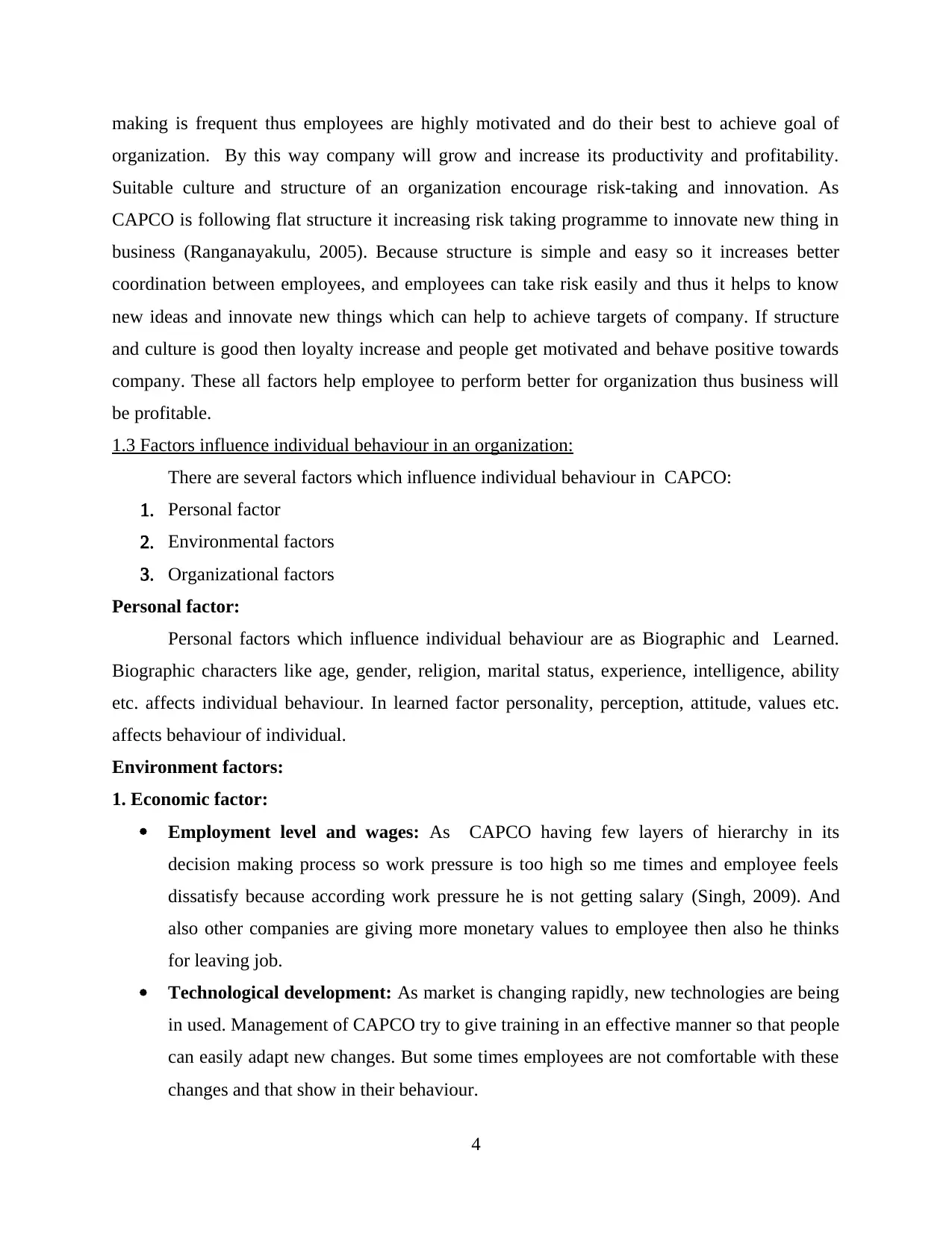
making is frequent thus employees are highly motivated and do their best to achieve goal of
organization. By this way company will grow and increase its productivity and profitability.
Suitable culture and structure of an organization encourage risk-taking and innovation. As
CAPCO is following flat structure it increasing risk taking programme to innovate new thing in
business (Ranganayakulu, 2005). Because structure is simple and easy so it increases better
coordination between employees, and employees can take risk easily and thus it helps to know
new ideas and innovate new things which can help to achieve targets of company. If structure
and culture is good then loyalty increase and people get motivated and behave positive towards
company. These all factors help employee to perform better for organization thus business will
be profitable.
1.3 Factors influence individual behaviour in an organization:
There are several factors which influence individual behaviour in CAPCO:
1. Personal factor
2. Environmental factors
3. Organizational factors
Personal factor:
Personal factors which influence individual behaviour are as Biographic and Learned.
Biographic characters like age, gender, religion, marital status, experience, intelligence, ability
etc. affects individual behaviour. In learned factor personality, perception, attitude, values etc.
affects behaviour of individual.
Environment factors:
1. Economic factor:
Employment level and wages: As CAPCO having few layers of hierarchy in its
decision making process so work pressure is too high so me times and employee feels
dissatisfy because according work pressure he is not getting salary (Singh, 2009). And
also other companies are giving more monetary values to employee then also he thinks
for leaving job.
Technological development: As market is changing rapidly, new technologies are being
in used. Management of CAPCO try to give training in an effective manner so that people
can easily adapt new changes. But some times employees are not comfortable with these
changes and that show in their behaviour.
4
organization. By this way company will grow and increase its productivity and profitability.
Suitable culture and structure of an organization encourage risk-taking and innovation. As
CAPCO is following flat structure it increasing risk taking programme to innovate new thing in
business (Ranganayakulu, 2005). Because structure is simple and easy so it increases better
coordination between employees, and employees can take risk easily and thus it helps to know
new ideas and innovate new things which can help to achieve targets of company. If structure
and culture is good then loyalty increase and people get motivated and behave positive towards
company. These all factors help employee to perform better for organization thus business will
be profitable.
1.3 Factors influence individual behaviour in an organization:
There are several factors which influence individual behaviour in CAPCO:
1. Personal factor
2. Environmental factors
3. Organizational factors
Personal factor:
Personal factors which influence individual behaviour are as Biographic and Learned.
Biographic characters like age, gender, religion, marital status, experience, intelligence, ability
etc. affects individual behaviour. In learned factor personality, perception, attitude, values etc.
affects behaviour of individual.
Environment factors:
1. Economic factor:
Employment level and wages: As CAPCO having few layers of hierarchy in its
decision making process so work pressure is too high so me times and employee feels
dissatisfy because according work pressure he is not getting salary (Singh, 2009). And
also other companies are giving more monetary values to employee then also he thinks
for leaving job.
Technological development: As market is changing rapidly, new technologies are being
in used. Management of CAPCO try to give training in an effective manner so that people
can easily adapt new changes. But some times employees are not comfortable with these
changes and that show in their behaviour.
4
⊘ This is a preview!⊘
Do you want full access?
Subscribe today to unlock all pages.

Trusted by 1+ million students worldwide
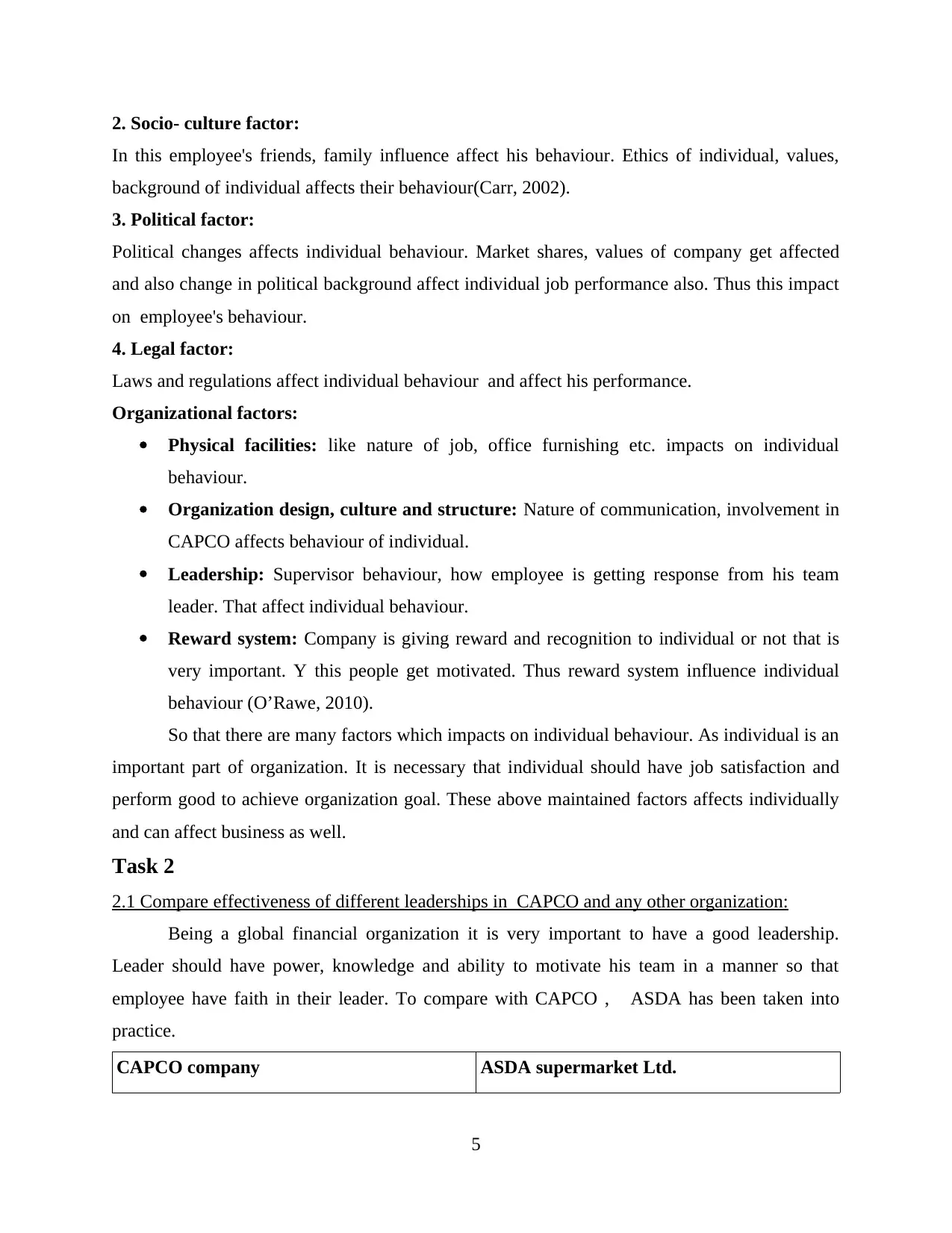
2. Socio- culture factor:
In this employee's friends, family influence affect his behaviour. Ethics of individual, values,
background of individual affects their behaviour(Carr, 2002).
3. Political factor:
Political changes affects individual behaviour. Market shares, values of company get affected
and also change in political background affect individual job performance also. Thus this impact
on employee's behaviour.
4. Legal factor:
Laws and regulations affect individual behaviour and affect his performance.
Organizational factors:
Physical facilities: like nature of job, office furnishing etc. impacts on individual
behaviour.
Organization design, culture and structure: Nature of communication, involvement in
CAPCO affects behaviour of individual.
Leadership: Supervisor behaviour, how employee is getting response from his team
leader. That affect individual behaviour.
Reward system: Company is giving reward and recognition to individual or not that is
very important. Y this people get motivated. Thus reward system influence individual
behaviour (O’Rawe, 2010).
So that there are many factors which impacts on individual behaviour. As individual is an
important part of organization. It is necessary that individual should have job satisfaction and
perform good to achieve organization goal. These above maintained factors affects individually
and can affect business as well.
Task 2
2.1 Compare effectiveness of different leaderships in CAPCO and any other organization:
Being a global financial organization it is very important to have a good leadership.
Leader should have power, knowledge and ability to motivate his team in a manner so that
employee have faith in their leader. To compare with CAPCO , ASDA has been taken into
practice.
CAPCO company ASDA supermarket Ltd.
5
In this employee's friends, family influence affect his behaviour. Ethics of individual, values,
background of individual affects their behaviour(Carr, 2002).
3. Political factor:
Political changes affects individual behaviour. Market shares, values of company get affected
and also change in political background affect individual job performance also. Thus this impact
on employee's behaviour.
4. Legal factor:
Laws and regulations affect individual behaviour and affect his performance.
Organizational factors:
Physical facilities: like nature of job, office furnishing etc. impacts on individual
behaviour.
Organization design, culture and structure: Nature of communication, involvement in
CAPCO affects behaviour of individual.
Leadership: Supervisor behaviour, how employee is getting response from his team
leader. That affect individual behaviour.
Reward system: Company is giving reward and recognition to individual or not that is
very important. Y this people get motivated. Thus reward system influence individual
behaviour (O’Rawe, 2010).
So that there are many factors which impacts on individual behaviour. As individual is an
important part of organization. It is necessary that individual should have job satisfaction and
perform good to achieve organization goal. These above maintained factors affects individually
and can affect business as well.
Task 2
2.1 Compare effectiveness of different leaderships in CAPCO and any other organization:
Being a global financial organization it is very important to have a good leadership.
Leader should have power, knowledge and ability to motivate his team in a manner so that
employee have faith in their leader. To compare with CAPCO , ASDA has been taken into
practice.
CAPCO company ASDA supermarket Ltd.
5
Paraphrase This Document
Need a fresh take? Get an instant paraphrase of this document with our AI Paraphraser
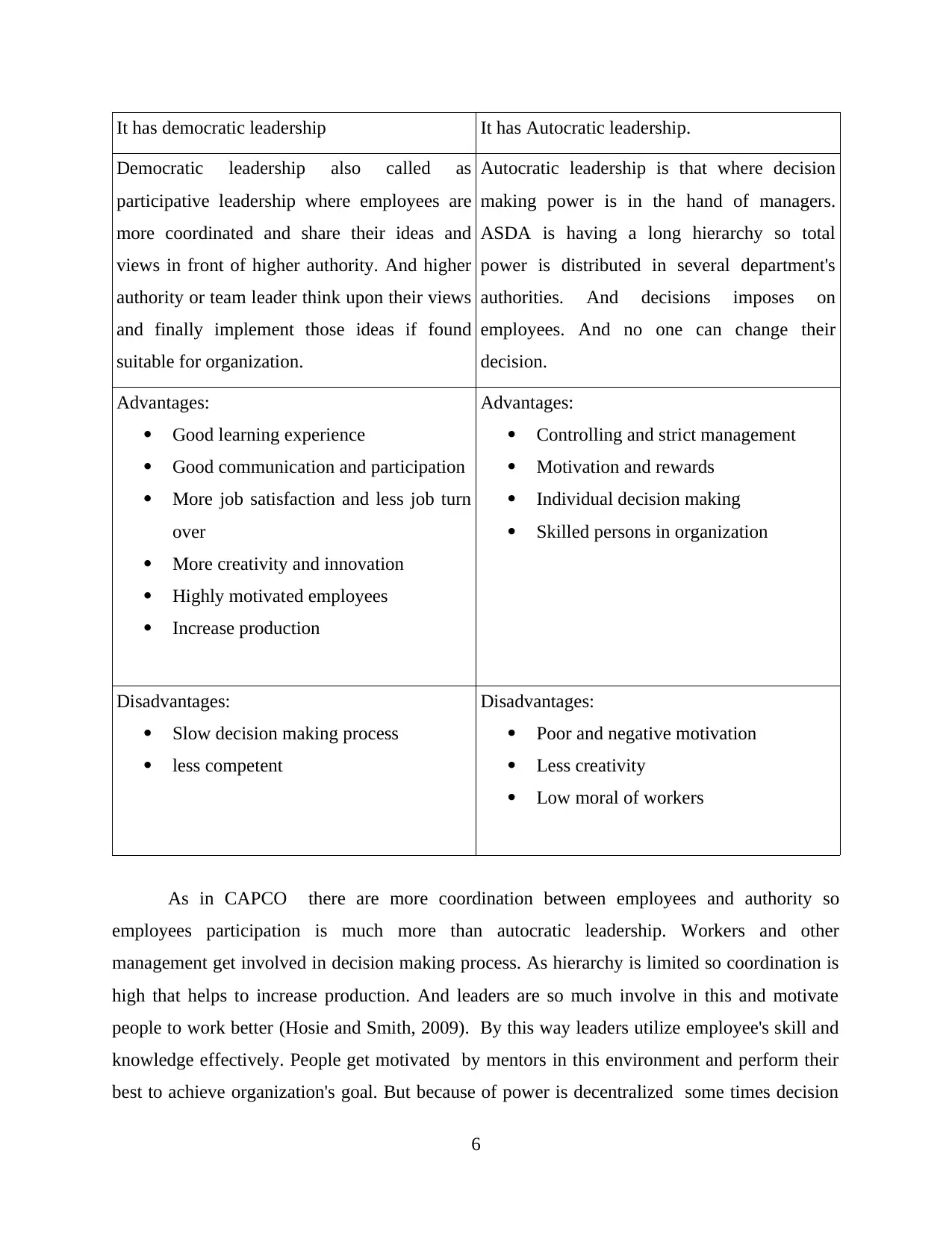
It has democratic leadership It has Autocratic leadership.
Democratic leadership also called as
participative leadership where employees are
more coordinated and share their ideas and
views in front of higher authority. And higher
authority or team leader think upon their views
and finally implement those ideas if found
suitable for organization.
Autocratic leadership is that where decision
making power is in the hand of managers.
ASDA is having a long hierarchy so total
power is distributed in several department's
authorities. And decisions imposes on
employees. And no one can change their
decision.
Advantages:
Good learning experience
Good communication and participation
More job satisfaction and less job turn
over
More creativity and innovation
Highly motivated employees
Increase production
Advantages:
Controlling and strict management
Motivation and rewards
Individual decision making
Skilled persons in organization
Disadvantages:
Slow decision making process
less competent
Disadvantages:
Poor and negative motivation
Less creativity
Low moral of workers
As in CAPCO there are more coordination between employees and authority so
employees participation is much more than autocratic leadership. Workers and other
management get involved in decision making process. As hierarchy is limited so coordination is
high that helps to increase production. And leaders are so much involve in this and motivate
people to work better (Hosie and Smith, 2009). By this way leaders utilize employee's skill and
knowledge effectively. People get motivated by mentors in this environment and perform their
best to achieve organization's goal. But because of power is decentralized some times decision
6
Democratic leadership also called as
participative leadership where employees are
more coordinated and share their ideas and
views in front of higher authority. And higher
authority or team leader think upon their views
and finally implement those ideas if found
suitable for organization.
Autocratic leadership is that where decision
making power is in the hand of managers.
ASDA is having a long hierarchy so total
power is distributed in several department's
authorities. And decisions imposes on
employees. And no one can change their
decision.
Advantages:
Good learning experience
Good communication and participation
More job satisfaction and less job turn
over
More creativity and innovation
Highly motivated employees
Increase production
Advantages:
Controlling and strict management
Motivation and rewards
Individual decision making
Skilled persons in organization
Disadvantages:
Slow decision making process
less competent
Disadvantages:
Poor and negative motivation
Less creativity
Low moral of workers
As in CAPCO there are more coordination between employees and authority so
employees participation is much more than autocratic leadership. Workers and other
management get involved in decision making process. As hierarchy is limited so coordination is
high that helps to increase production. And leaders are so much involve in this and motivate
people to work better (Hosie and Smith, 2009). By this way leaders utilize employee's skill and
knowledge effectively. People get motivated by mentors in this environment and perform their
best to achieve organization's goal. But because of power is decentralized some times decision
6
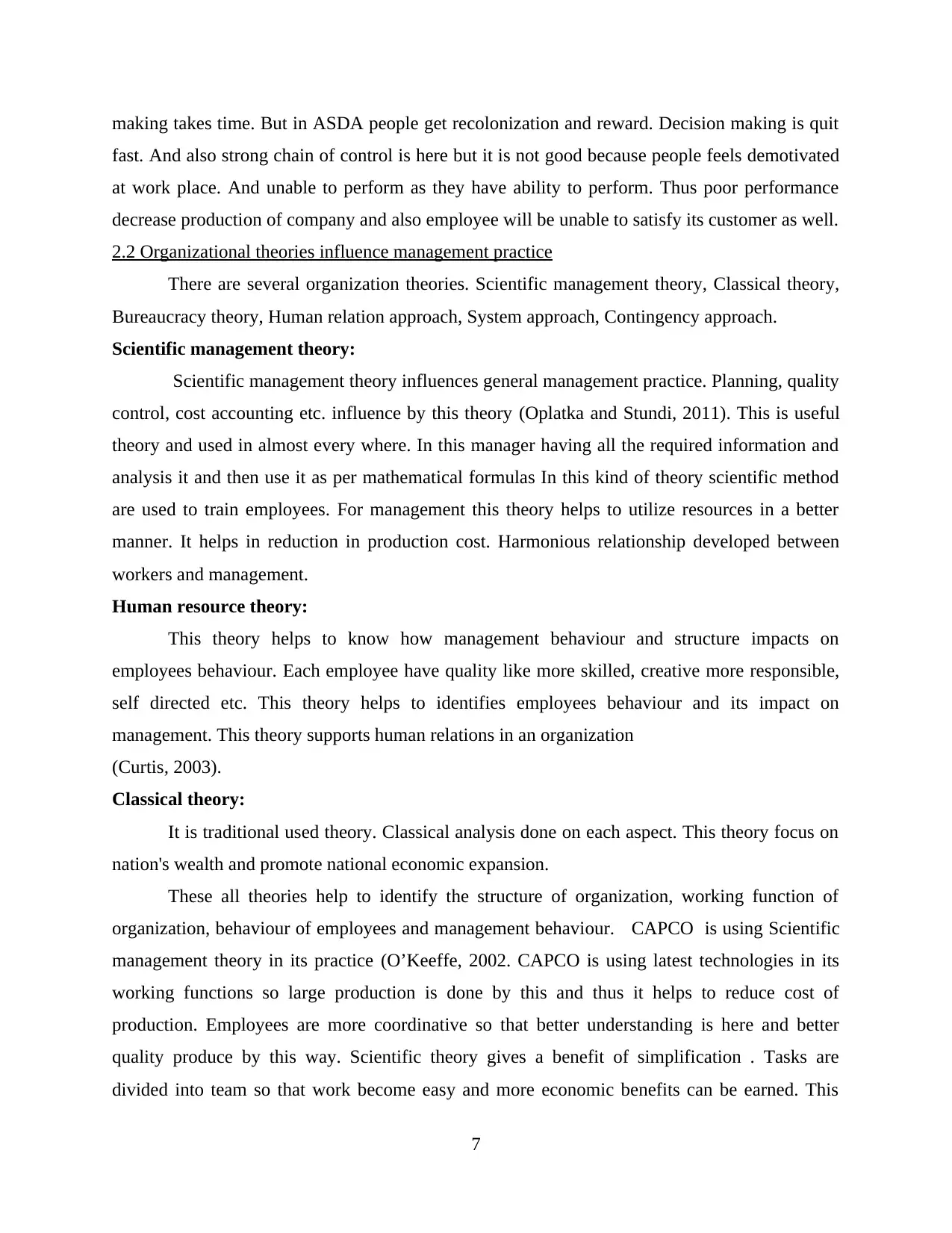
making takes time. But in ASDA people get recolonization and reward. Decision making is quit
fast. And also strong chain of control is here but it is not good because people feels demotivated
at work place. And unable to perform as they have ability to perform. Thus poor performance
decrease production of company and also employee will be unable to satisfy its customer as well.
2.2 Organizational theories influence management practice
There are several organization theories. Scientific management theory, Classical theory,
Bureaucracy theory, Human relation approach, System approach, Contingency approach.
Scientific management theory:
Scientific management theory influences general management practice. Planning, quality
control, cost accounting etc. influence by this theory (Oplatka and Stundi, 2011). This is useful
theory and used in almost every where. In this manager having all the required information and
analysis it and then use it as per mathematical formulas In this kind of theory scientific method
are used to train employees. For management this theory helps to utilize resources in a better
manner. It helps in reduction in production cost. Harmonious relationship developed between
workers and management.
Human resource theory:
This theory helps to know how management behaviour and structure impacts on
employees behaviour. Each employee have quality like more skilled, creative more responsible,
self directed etc. This theory helps to identifies employees behaviour and its impact on
management. This theory supports human relations in an organization
(Curtis, 2003).
Classical theory:
It is traditional used theory. Classical analysis done on each aspect. This theory focus on
nation's wealth and promote national economic expansion.
These all theories help to identify the structure of organization, working function of
organization, behaviour of employees and management behaviour. CAPCO is using Scientific
management theory in its practice (O’Keeffe, 2002. CAPCO is using latest technologies in its
working functions so large production is done by this and thus it helps to reduce cost of
production. Employees are more coordinative so that better understanding is here and better
quality produce by this way. Scientific theory gives a benefit of simplification . Tasks are
divided into team so that work become easy and more economic benefits can be earned. This
7
fast. And also strong chain of control is here but it is not good because people feels demotivated
at work place. And unable to perform as they have ability to perform. Thus poor performance
decrease production of company and also employee will be unable to satisfy its customer as well.
2.2 Organizational theories influence management practice
There are several organization theories. Scientific management theory, Classical theory,
Bureaucracy theory, Human relation approach, System approach, Contingency approach.
Scientific management theory:
Scientific management theory influences general management practice. Planning, quality
control, cost accounting etc. influence by this theory (Oplatka and Stundi, 2011). This is useful
theory and used in almost every where. In this manager having all the required information and
analysis it and then use it as per mathematical formulas In this kind of theory scientific method
are used to train employees. For management this theory helps to utilize resources in a better
manner. It helps in reduction in production cost. Harmonious relationship developed between
workers and management.
Human resource theory:
This theory helps to know how management behaviour and structure impacts on
employees behaviour. Each employee have quality like more skilled, creative more responsible,
self directed etc. This theory helps to identifies employees behaviour and its impact on
management. This theory supports human relations in an organization
(Curtis, 2003).
Classical theory:
It is traditional used theory. Classical analysis done on each aspect. This theory focus on
nation's wealth and promote national economic expansion.
These all theories help to identify the structure of organization, working function of
organization, behaviour of employees and management behaviour. CAPCO is using Scientific
management theory in its practice (O’Keeffe, 2002. CAPCO is using latest technologies in its
working functions so large production is done by this and thus it helps to reduce cost of
production. Employees are more coordinative so that better understanding is here and better
quality produce by this way. Scientific theory gives a benefit of simplification . Tasks are
divided into team so that work become easy and more economic benefits can be earned. This
7
⊘ This is a preview!⊘
Do you want full access?
Subscribe today to unlock all pages.

Trusted by 1+ million students worldwide
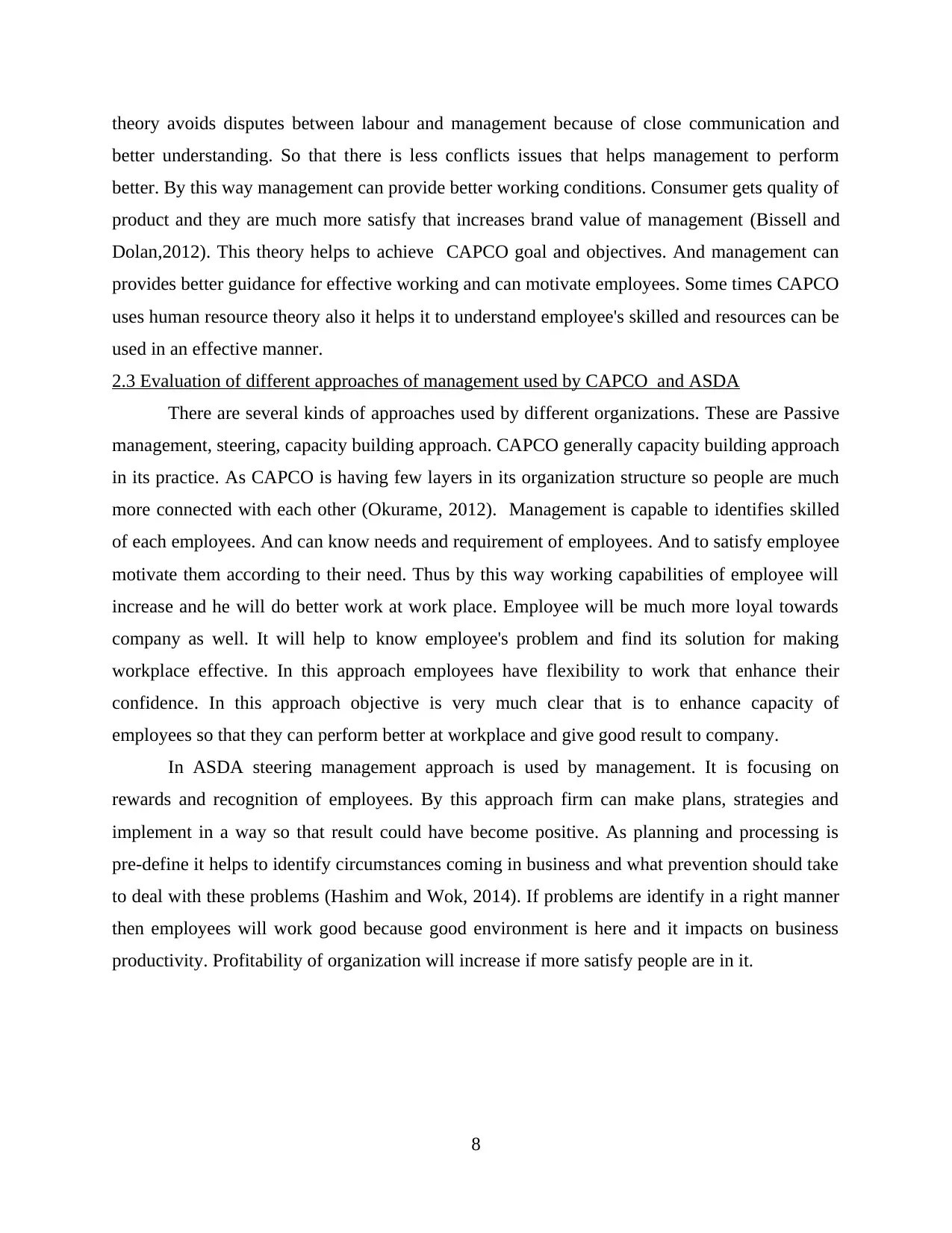
theory avoids disputes between labour and management because of close communication and
better understanding. So that there is less conflicts issues that helps management to perform
better. By this way management can provide better working conditions. Consumer gets quality of
product and they are much more satisfy that increases brand value of management (Bissell and
Dolan,2012). This theory helps to achieve CAPCO goal and objectives. And management can
provides better guidance for effective working and can motivate employees. Some times CAPCO
uses human resource theory also it helps it to understand employee's skilled and resources can be
used in an effective manner.
2.3 Evaluation of different approaches of management used by CAPCO and ASDA
There are several kinds of approaches used by different organizations. These are Passive
management, steering, capacity building approach. CAPCO generally capacity building approach
in its practice. As CAPCO is having few layers in its organization structure so people are much
more connected with each other (Okurame, 2012). Management is capable to identifies skilled
of each employees. And can know needs and requirement of employees. And to satisfy employee
motivate them according to their need. Thus by this way working capabilities of employee will
increase and he will do better work at work place. Employee will be much more loyal towards
company as well. It will help to know employee's problem and find its solution for making
workplace effective. In this approach employees have flexibility to work that enhance their
confidence. In this approach objective is very much clear that is to enhance capacity of
employees so that they can perform better at workplace and give good result to company.
In ASDA steering management approach is used by management. It is focusing on
rewards and recognition of employees. By this approach firm can make plans, strategies and
implement in a way so that result could have become positive. As planning and processing is
pre-define it helps to identify circumstances coming in business and what prevention should take
to deal with these problems (Hashim and Wok, 2014). If problems are identify in a right manner
then employees will work good because good environment is here and it impacts on business
productivity. Profitability of organization will increase if more satisfy people are in it.
8
better understanding. So that there is less conflicts issues that helps management to perform
better. By this way management can provide better working conditions. Consumer gets quality of
product and they are much more satisfy that increases brand value of management (Bissell and
Dolan,2012). This theory helps to achieve CAPCO goal and objectives. And management can
provides better guidance for effective working and can motivate employees. Some times CAPCO
uses human resource theory also it helps it to understand employee's skilled and resources can be
used in an effective manner.
2.3 Evaluation of different approaches of management used by CAPCO and ASDA
There are several kinds of approaches used by different organizations. These are Passive
management, steering, capacity building approach. CAPCO generally capacity building approach
in its practice. As CAPCO is having few layers in its organization structure so people are much
more connected with each other (Okurame, 2012). Management is capable to identifies skilled
of each employees. And can know needs and requirement of employees. And to satisfy employee
motivate them according to their need. Thus by this way working capabilities of employee will
increase and he will do better work at work place. Employee will be much more loyal towards
company as well. It will help to know employee's problem and find its solution for making
workplace effective. In this approach employees have flexibility to work that enhance their
confidence. In this approach objective is very much clear that is to enhance capacity of
employees so that they can perform better at workplace and give good result to company.
In ASDA steering management approach is used by management. It is focusing on
rewards and recognition of employees. By this approach firm can make plans, strategies and
implement in a way so that result could have become positive. As planning and processing is
pre-define it helps to identify circumstances coming in business and what prevention should take
to deal with these problems (Hashim and Wok, 2014). If problems are identify in a right manner
then employees will work good because good environment is here and it impacts on business
productivity. Profitability of organization will increase if more satisfy people are in it.
8
Paraphrase This Document
Need a fresh take? Get an instant paraphrase of this document with our AI Paraphraser
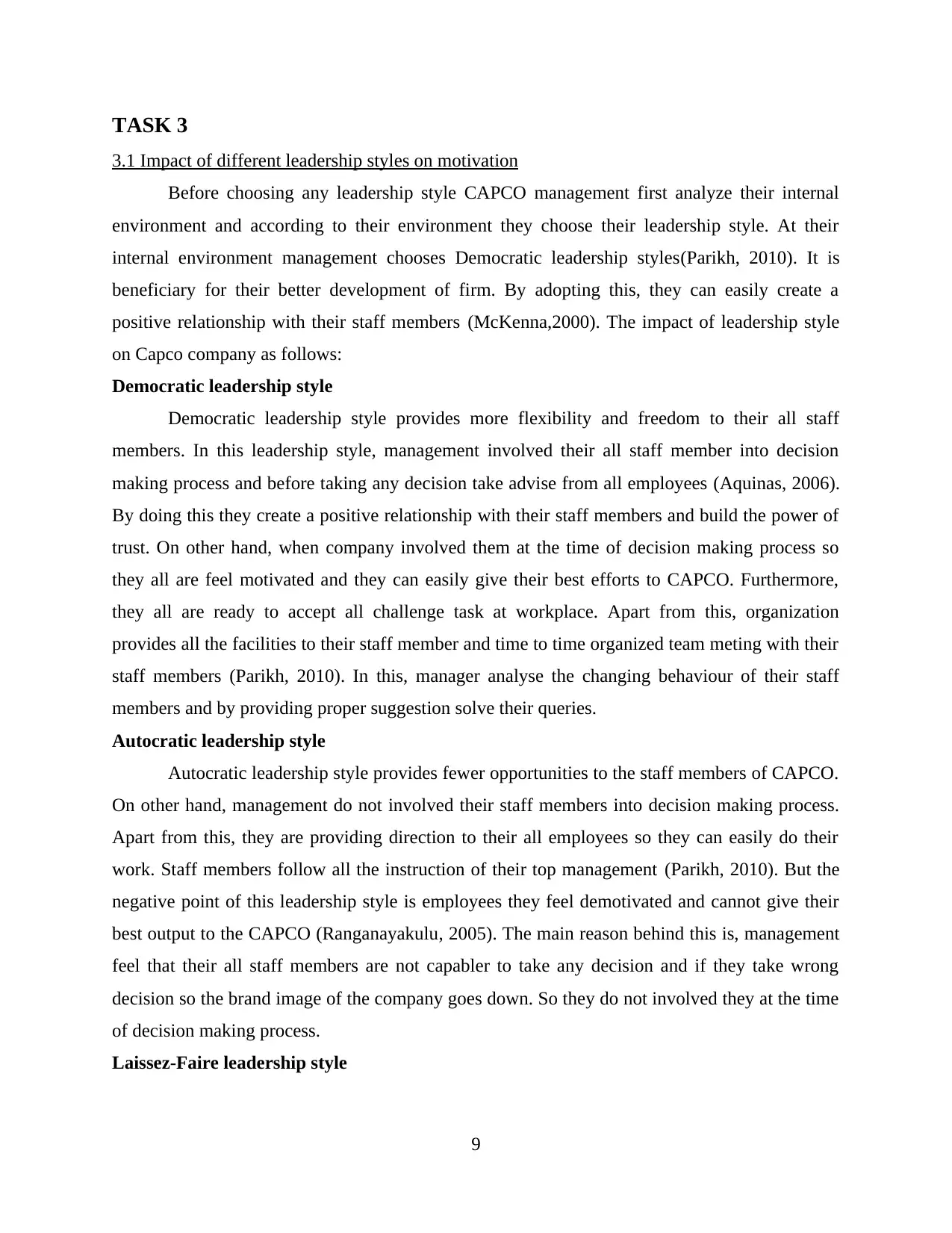
TASK 3
3.1 Impact of different leadership styles on motivation
Before choosing any leadership style CAPCO management first analyze their internal
environment and according to their environment they choose their leadership style. At their
internal environment management chooses Democratic leadership styles(Parikh, 2010). It is
beneficiary for their better development of firm. By adopting this, they can easily create a
positive relationship with their staff members (McKenna,2000). The impact of leadership style
on Capco company as follows:
Democratic leadership style
Democratic leadership style provides more flexibility and freedom to their all staff
members. In this leadership style, management involved their all staff member into decision
making process and before taking any decision take advise from all employees (Aquinas, 2006).
By doing this they create a positive relationship with their staff members and build the power of
trust. On other hand, when company involved them at the time of decision making process so
they all are feel motivated and they can easily give their best efforts to CAPCO. Furthermore,
they all are ready to accept all challenge task at workplace. Apart from this, organization
provides all the facilities to their staff member and time to time organized team meting with their
staff members (Parikh, 2010). In this, manager analyse the changing behaviour of their staff
members and by providing proper suggestion solve their queries.
Autocratic leadership style
Autocratic leadership style provides fewer opportunities to the staff members of CAPCO.
On other hand, management do not involved their staff members into decision making process.
Apart from this, they are providing direction to their all employees so they can easily do their
work. Staff members follow all the instruction of their top management (Parikh, 2010). But the
negative point of this leadership style is employees they feel demotivated and cannot give their
best output to the CAPCO (Ranganayakulu, 2005). The main reason behind this is, management
feel that their all staff members are not capabler to take any decision and if they take wrong
decision so the brand image of the company goes down. So they do not involved they at the time
of decision making process.
Laissez-Faire leadership style
9
3.1 Impact of different leadership styles on motivation
Before choosing any leadership style CAPCO management first analyze their internal
environment and according to their environment they choose their leadership style. At their
internal environment management chooses Democratic leadership styles(Parikh, 2010). It is
beneficiary for their better development of firm. By adopting this, they can easily create a
positive relationship with their staff members (McKenna,2000). The impact of leadership style
on Capco company as follows:
Democratic leadership style
Democratic leadership style provides more flexibility and freedom to their all staff
members. In this leadership style, management involved their all staff member into decision
making process and before taking any decision take advise from all employees (Aquinas, 2006).
By doing this they create a positive relationship with their staff members and build the power of
trust. On other hand, when company involved them at the time of decision making process so
they all are feel motivated and they can easily give their best efforts to CAPCO. Furthermore,
they all are ready to accept all challenge task at workplace. Apart from this, organization
provides all the facilities to their staff member and time to time organized team meting with their
staff members (Parikh, 2010). In this, manager analyse the changing behaviour of their staff
members and by providing proper suggestion solve their queries.
Autocratic leadership style
Autocratic leadership style provides fewer opportunities to the staff members of CAPCO.
On other hand, management do not involved their staff members into decision making process.
Apart from this, they are providing direction to their all employees so they can easily do their
work. Staff members follow all the instruction of their top management (Parikh, 2010). But the
negative point of this leadership style is employees they feel demotivated and cannot give their
best output to the CAPCO (Ranganayakulu, 2005). The main reason behind this is, management
feel that their all staff members are not capabler to take any decision and if they take wrong
decision so the brand image of the company goes down. So they do not involved they at the time
of decision making process.
Laissez-Faire leadership style
9
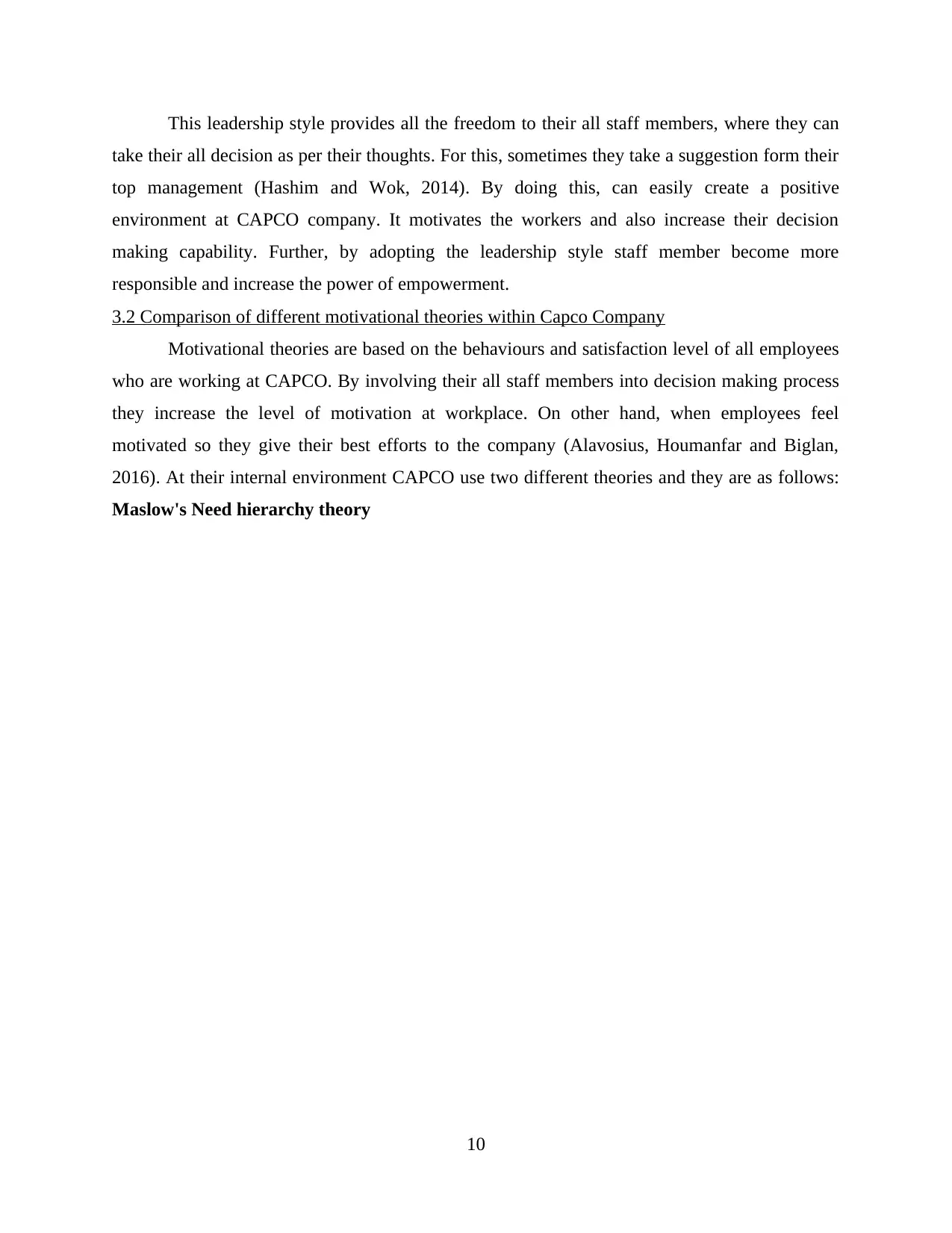
This leadership style provides all the freedom to their all staff members, where they can
take their all decision as per their thoughts. For this, sometimes they take a suggestion form their
top management (Hashim and Wok, 2014). By doing this, can easily create a positive
environment at CAPCO company. It motivates the workers and also increase their decision
making capability. Further, by adopting the leadership style staff member become more
responsible and increase the power of empowerment.
3.2 Comparison of different motivational theories within Capco Company
Motivational theories are based on the behaviours and satisfaction level of all employees
who are working at CAPCO. By involving their all staff members into decision making process
they increase the level of motivation at workplace. On other hand, when employees feel
motivated so they give their best efforts to the company (Alavosius, Houmanfar and Biglan,
2016). At their internal environment CAPCO use two different theories and they are as follows:
Maslow's Need hierarchy theory
10
take their all decision as per their thoughts. For this, sometimes they take a suggestion form their
top management (Hashim and Wok, 2014). By doing this, can easily create a positive
environment at CAPCO company. It motivates the workers and also increase their decision
making capability. Further, by adopting the leadership style staff member become more
responsible and increase the power of empowerment.
3.2 Comparison of different motivational theories within Capco Company
Motivational theories are based on the behaviours and satisfaction level of all employees
who are working at CAPCO. By involving their all staff members into decision making process
they increase the level of motivation at workplace. On other hand, when employees feel
motivated so they give their best efforts to the company (Alavosius, Houmanfar and Biglan,
2016). At their internal environment CAPCO use two different theories and they are as follows:
Maslow's Need hierarchy theory
10
⊘ This is a preview!⊘
Do you want full access?
Subscribe today to unlock all pages.

Trusted by 1+ million students worldwide
1 out of 21
Related Documents
Your All-in-One AI-Powered Toolkit for Academic Success.
+13062052269
info@desklib.com
Available 24*7 on WhatsApp / Email
![[object Object]](/_next/static/media/star-bottom.7253800d.svg)
Unlock your academic potential
Copyright © 2020–2025 A2Z Services. All Rights Reserved. Developed and managed by ZUCOL.





